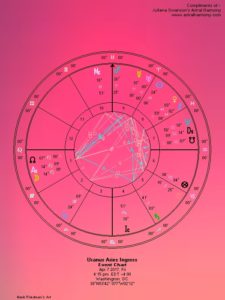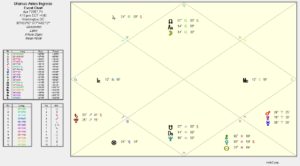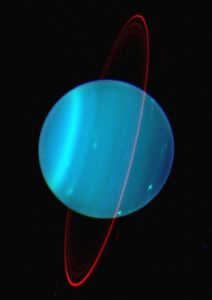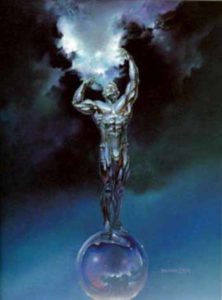On April 7, 2017, transiting Uranus entered the constellation of Aries, which is known as the Uranus-Aries ingress. This represents a significant sea-change which was set in motion last summer when Uranus entered Aries for a short while. Uranus entered sidereal Aries on June 27, 2016 and remained there until August 31, 2016. From August 31, 2016 until April 7, 2017, Uranus completed its Pisces transit. Uranus transited the most precarious section between Pisces and Aries, called the nakshatra gandanta—the last 3 deg. 20 min of Pisces and first 3 deg. 20 min. of Aries—from April 15, 2016 to December 7, 2016, and again transitins in the nakshatra gandanta from Jan. 20, 2017 until June 11, 2017. Uranus will remain in the constellation of Aries until March 18, 2025, but will move into Taurus for a brief period from June-December 2024 and then again into Taurus in March 2025.


 As a Neo-Vedic astrologer, I use the outer planets Uranus, Neptune, and Pluto in their sidereal positions (Lahiri ayanamsha), but I rarely assign rulership, dignity, and debility to them. In natal readings, I usually only use them when they make close contacts natally or by transit to the traditional grahas or angles (kendra cusps) of the chart, and I use them in chart element analysis, attributing one point to each of them in their respective rashis (signs). In mundane astrology, the “outers” become quite important as representatives of collective forces, and I will especially watch their transits in relation to various mundane horoscopes. Outer planet transits into a new sign are quite significant in natal or mundane astrology as they move relatively slowly compared to the grahas of Vedic astrology, and thus represent generational and semi-generational cycles which are much larger than those of the grahas.
As a Neo-Vedic astrologer, I use the outer planets Uranus, Neptune, and Pluto in their sidereal positions (Lahiri ayanamsha), but I rarely assign rulership, dignity, and debility to them. In natal readings, I usually only use them when they make close contacts natally or by transit to the traditional grahas or angles (kendra cusps) of the chart, and I use them in chart element analysis, attributing one point to each of them in their respective rashis (signs). In mundane astrology, the “outers” become quite important as representatives of collective forces, and I will especially watch their transits in relation to various mundane horoscopes. Outer planet transits into a new sign are quite significant in natal or mundane astrology as they move relatively slowly compared to the grahas of Vedic astrology, and thus represent generational and semi-generational cycles which are much larger than those of the grahas.
According to P.S. Sastri in his Textbook on Scientific Hindu Astrology, there is mention of the outer planets in the Mahabharata, though there is some debate over the identification of Varuna with the planet Neptune. Dr. Dennis Harness wrote an illuminating article about the outer planets (in particular, Pluto) titled “Pluto: A Neo-Vedic View,” in which he mentions discussing the outer planets with the late Vedic astrologer Narendra Desai. Apparently, Desai said he had examined the Vasishta Nadi (ancient palm leaf text) in the Madras Museum, and that this nadi states that the planets which are invisible to the naked eye would be discovered, and that their astrological use would be understood, in the Kali Yuga. Interestingly, Desai always considered Uranus to be the main karaka of astrology and astrologers.
Dr. Harness further explained, “The palm leaf went on to reveal that the jyotishi’s [sic, jyotishis] of Kali Yuga would need to decipher the significance and meaning of these powerful grahas. It was refreshing to hear a traditional jyotishi from India speak with such an open mind toward the influence of the outer planets.” Contemporary western astrology believes that the outer planets have been “discovered” at times in history when their particular significations suddenly became more germane to the ethos of the time. In other words, the historical era in which an outer planet was discovered and the circumstances around the discovery reflect the astrological qualities of the planet.
As an example, Uranus was discovered on March 13, 1781 by William Herschel. He found it with the telescope which is a Uranian device. Uranus has an odd rotational axis which is almost level to its orbital plane. The axis is tilted 98 degrees compared to the Sun’s orbital plane, so Uranus lies nearly sideways, tipped on its side with respect to the plane of its orbit around the Sun. Compare this with Earth’s much smaller 23.5 degree tilt. So you could say that Uranus rotates and looks like a Ferris Wheel, and thus in astrology has come to represent unconventionality by virtue of its eccentric movement, and also represents the principle of the wheel (revolution). Figuratively, Uranus in astrology has come to symbolize revolutionary and exciting events, and Uranian transits truly do often feel like a wild carnival ride!
 Credit: Lawrence Sromovsky (Univ. Wisconsin-Madison), Keck Observatory
Credit: Lawrence Sromovsky (Univ. Wisconsin-Madison), Keck Observatory
Note that the Industrial Revolution started around the time that Uranus transited Aries from 1764-1773, which began mainly with the innovation of textile machinery such as the Spinning Jenny (1764), a multi-spindle spinning frame with a large wheel, which was a key development in the industrialization of weaving. This would be of course a literal representation of Uranus’ wheel principle, whereas Mars-ruled Aries points to mechanical or technical invention.
 In ancient Greek literature, Uranus or Father Sky was the son and husband of Gaia, Mother Earth. Their child Cronus, or Kronos (Saturn), overthrew his father and ruled during the mythological Golden Age. Therefore, Uranus is often associated with questioning authority and deposing leaders. A symbol of revolution, Uranus was discovered not only at the beginning of the Industrial Revolution, as mentioned, but also during the American War of Independence.
In ancient Greek literature, Uranus or Father Sky was the son and husband of Gaia, Mother Earth. Their child Cronus, or Kronos (Saturn), overthrew his father and ruled during the mythological Golden Age. Therefore, Uranus is often associated with questioning authority and deposing leaders. A symbol of revolution, Uranus was discovered not only at the beginning of the Industrial Revolution, as mentioned, but also during the American War of Independence.
Aries energy can be aggressive or assertive, creative, fiery, explosive, driven, selfish, creative, enthusiastic, impatient, and competitive. Uranus is the big surprise factor in life, independent, rebellious, inventive, unstable, shocking, electrified, turned upside down, and explosive. Put them together and you get things moving very fast and sometimes erratically, but there’s also a true pioneering dynamic here, with a high spirit of initiative, individualism, daring, and adventure, which can also be be temperamental, explosive, impulsive, fanatical, and violent.
 As the higher octave of Mercury, Uranus is known as the “Great Awakener” and represents the spiritual intellect or higher mind. It also rules over kundalini energy, psychic power, astrology, and modern humanistic sciences such as psychology, sociology, and anthropology. Often called the “Bolt out of the Blue,” Uranus is connected to lightning strikes; earthquakes and volcanic activity; and sudden, shocking, explosive, and upsetting accidents or events. A symbol of exploration, anarchy, demonstrations, riots, eruptions of political tension, extreme political ideas, and free-market enterprise, Uranus is all about the urge for evolution, liberty, and individualism.
As the higher octave of Mercury, Uranus is known as the “Great Awakener” and represents the spiritual intellect or higher mind. It also rules over kundalini energy, psychic power, astrology, and modern humanistic sciences such as psychology, sociology, and anthropology. Often called the “Bolt out of the Blue,” Uranus is connected to lightning strikes; earthquakes and volcanic activity; and sudden, shocking, explosive, and upsetting accidents or events. A symbol of exploration, anarchy, demonstrations, riots, eruptions of political tension, extreme political ideas, and free-market enterprise, Uranus is all about the urge for evolution, liberty, and individualism.
Aries is a sign of innovation and enterprise. It is the fire principle which is the creative force behind manifestation. Uranus is the futuristic planet which stands for scientific advancement and technological inventions, particularly those using wheels, electricity, and electronics. Transportation and vehicles including automobiles, railways, spaceships, and airplanes also come under Uranus. Such areas of life will be expressly emphasized as Uranus transits in the Ashwini nakshatra section of Aries from 0-13 degrees 20 minutes, since Ashwini is the section of Aries most connected to pioneering invention. As Ashwini is also the nakshatra of healing and medicine, we will see some amazing new developments in the field of medicine in the coming few years.
 Uranus has an orbit of 84 years and spends an average of seven years in each sign. Because of its extensive retrograde cycles, the full span of time often appears longer than seven years. Following are the dates when Uranus transited in sidereal Aries in the past 300+ years:
Uranus has an orbit of 84 years and spends an average of seven years in each sign. Because of its extensive retrograde cycles, the full span of time often appears longer than seven years. Following are the dates when Uranus transited in sidereal Aries in the past 300+ years:
- 1680-1689
- 1764-1773
- 1848-1857
- 1932-1941
Uranus has been transiting in Pisces on and off from April 6, 2009 and will leave here on April 7, 2017. This was during much of President Obama’s term in office. This transit is associated with a heightened sense of hope, compassionate social reform, unrealized idealism, and extreme ideologies. Uranus relates to fanatics, and Pisces rules religion and ideology, so of course, this period also saw the rise and spread of ISIS. In this period, America also experienced the opposite of fundamentalist Islam, i.e., an upsurge in atheism, which is defined as the absence of beliefs in gods which can occur inside or outside the context of religion (Uranus = “freedom from” and Pisces = religion). The Uranus in Pisces period also witnessed the federal legalization of same-sex marriage, and in many states, the legalization of marijuana. All this fits with Uranus in Pisces, as Pisces symbolizes a sense of inclusiveness and also represents drugs, and Uranus is a revolutionary force of social change.
Uranus in Aries will be a time when there is a great demand for rapid change. It will be a period of exploration, new discoveries, and swift resolutions and improvements. Many new trails will be blazed in the building, manufacturing, and technology industries in the coming years. At the same time, Mars-ruled Aries relates to political fanatics; fires and accidents; rebellions, crime and criminals; violence, the military and war; and epidemics. All these matters could be highlighted in this period. When Uranus in Aries is afflicted as it will be by the trine from the Moon’s North Node Rahu from April through August, this is a time when there may be civil unrest such as we saw in France and America in the summer of 2016 when Uranus was in Aries. This may also be a time of some political and military strife or seismic events, all of which may be extremely troubling and dangerous.
Uranus in Aries is a time of wars, revolutions, and the rise of nationalism. In 1683 during the Uranus Aries transit, an Ottoman Empire army penetrated the outer fortifications of Vienna – during what is to be known as the Second Siege of Vienna. By 1687, the Ottomans were falling back. In 1688, the Glorious Revolution, also called the Revolution of 1688, involved the overthrow of King James II of England (James VII of Scotland) by a union of English Parliamentarians with William III, Prince of Orange. Uranus entered Aries in 1764 which marked the beginning of the American Revolutionary War period when the Colonists began to reject the authority of British Parliament to tax without representation. During the next Uranus Aries transit in 1848, Europe experienced the most extensive revolutionary period in history in a series of political upheavals throughout Europe known as Spring of Nations or Year of Revolution.
One example among the many episodes of the 1848 “People’s Spring” occurred in June 1848 when Uranus entered Aries and a revolution occurred in Romania. Known as the Wallachian Revolution, it involved a nationalist uprising in the Principality of Wallachia. In Thailand in June 1932 at the Uranus Aries ingress, the Siamese revolution (Siamese coup d’état) occurred, which was a crucial turning point in 20th-century Thai history. In India during the 1930s when Uranus transited Aries, British attitudes towards India were beginning to dramatically shift, partly as a result of Gandhi’s efforts and protests and the work of other nationalist leaders like Jawaharlal Nehru. Now as Uranus moves back to Aries in 2016-2017, we are again seeing the rise of new nationalist movements.
Uranus in Aries is associated with cutting-edge scientific discoveries, as in the case of Sir Isaac Newton who in 1686 presented his Principia, Book I, to the Royal Society. This book is thought by many to be the greatest science book ever written. It completely changed the way people saw the universe. Uranus in Aries refers to not only metaphoric pioneers like Newton, but also to literal explorers and trailblazers, such as the first settlers from Germany who came to the US aboard the Concord in 1683. Aries as a sign can also be self-interested to the point of not caring who or what is harmed in the drive to get ahead. For example, in 1848 when Uranus entered Aries, the California Gold Rush began, swiftly ushering in a decade of dramatic economic and social change which was yet another disgraceful period in American history.
It is estimated that 300,000 Gold Rush migrants flooded into California from not only America but also from Mexico, Chile, Peru, and China from 1848-1855. Many violent clashes ensued among these settlers and miners and the Native Americans over access to the land and its natural resources. The migrants and their mines devastated Native populations and poisoned the ecosystem. At the same time in Australia in 1848, the first non-British ship carrying immigrants arrived from Germany, known as the Goddefroy. Many of those on board were political refugees and came to be known as the “Forty-Eighters.”
Aries in mundane astrology is associated with deserts, barren lands, and desolate conditions, and Uranian energy can be dynamic and brutal. This Mars in Aries combination has been historically associated with drought and/or famine, as in the “Dirty Thirties” or “Dust Bowl” which occurred in the 1930s due to severe dust storms that greatly spoiled the ecosystem and agriculture of the American and Canadian prairies. The Holodomor famine in the Soviet Ukraine, one of the worst peacetime and man-made famines in history, occurred in 1932-33. According to some estimates, 7-10 million people, mostly “Ethnic Ukrainians,” died by a famine-genocide carried out by the Soviet government. There was another famine in the Soviet Union in the same period.
The so-called “Silent Generation” were born from the mid-1920s to the mid-1940s and lived during the Great Depression (1929-1939), thus during the Uranus in Aries period (1932-1941). Their generation has been labeled patriotic and ambitious, as Uranus in Aries fights for freedom and individualism. This generation also lived in an era plagued by civil unrest and war, and also it was a time of economic uncertainty (as mentioned, the Great Depression). Mars in Vedic astrology is Bhoomi Karaka, significator of the Earth and its resources; thus Mars and its sign of Aries are significators (karakas) of the economy, and Uranus of course represents unstable conditions.
In America’s Sagittarius-rising birth chart (US Kelleher chart), Aries is the sign in the fifth house, in which resides the Imum Coeli (IC) at 2 degrees of Aries. The IC is also called the patala lagna and is the chalita bhava chart’s fourth house cusp, which is the midnight point that relates to the homeland of the country; the opposition party to the government; municipal politics (like the impending conflict between so-called “sanctuary cities” and the federal government); and also the IC rules land, real estate, earthquakes, floods, mining disasters, volcanic eruptions, educational institutions, and agriculture. Uranus is closely activating the US chart IC now and through late May, so it may be a wild ride ahead in regard to any of these matters.
As Uranus transits Aries in the US chart until 2025, we will see some unpredictable events, challenges, conflicts, or major changes in fifth house affairs which include public education, the sports and entertainment industries, mining industry, stocks and public investments, the US Senate, and the leader of the country (fifth house is eighth house of struggles and transformation from the tenth/ house of government and leader).
 A few days before the last Uranus Aries ingress in June 2016, the people of the United Kingdom voted to leave the European Union (Brexit). The tragic and shocking Orlando, Florida nightclub terror attack also occurred 12 days before the ingress in June 2016. We are in that same kind of cycle again now, a very sensitive time now and into the summer when we are advised to avoid unnecessary exposure to dangerous situations and places, and when radical change may occur in various world governments and social or educational institutions. We should definitely expect the unexpected in the months ahead, but also heed the advice of the late spiritual teacher Paramahansa Yogananda who said,
A few days before the last Uranus Aries ingress in June 2016, the people of the United Kingdom voted to leave the European Union (Brexit). The tragic and shocking Orlando, Florida nightclub terror attack also occurred 12 days before the ingress in June 2016. We are in that same kind of cycle again now, a very sensitive time now and into the summer when we are advised to avoid unnecessary exposure to dangerous situations and places, and when radical change may occur in various world governments and social or educational institutions. We should definitely expect the unexpected in the months ahead, but also heed the advice of the late spiritual teacher Paramahansa Yogananda who said,
Be not afraid of the frightening dream of this world. Awaken in God’s immortal light! There was a time when life, to me, was like helplessly watching a terrifying movie, and I was giving too much importance to the tragedies being enacted therein. Then, one day while I was meditating, a great light appeared in my room and God’s voice said to me: ‘What are you dreaming about? Behold My eternal light, in which the many nightmares of the world come and go. They are not real.’ What a tremendous consolation it was! Nightmares, however dreadful, are merely nightmares. Movies, whether enjoyable or disturbing, are merely movies. We ought not to keep our minds so absorbed in the sad and frightening dramas of this life. Is it not wiser to place our attention on that Power which is indestructible and unchanging? Why worry about the unpleasant surprises in the plot of this world movie! We are here for just a little while. Learn the lesson of the drama of life and find your freedom.
 In an individual birth chart, if Uranus in Aries is closely aspecting important natal planets or chart points within 1-2 degrees, then the combination of Uranus in Aries can indicate restless or nervous energy, turmoil, or inner tension which can trigger inflammation, accidents, or eruptions. An astrological analysis of the birth horoscope will reveal these aspects and when the most sensitive periods will be. If we are being influenced by this transit, it helps to prevent problems if we are extra-mindful of running our energy in a balanced and easy way. With Uranus in Aries closely aspecting the natal chart, it is important not to be hasty, impulsive, or to take risks as this combination can be volatile, accident prone, and generally unpredictable. On the plus side, Uranus in Aries if contacting your natal chart suggests some extraordinary new creative and inventive energy, amazing journeys, and some truly surprising new opportunities and discoveries.
In an individual birth chart, if Uranus in Aries is closely aspecting important natal planets or chart points within 1-2 degrees, then the combination of Uranus in Aries can indicate restless or nervous energy, turmoil, or inner tension which can trigger inflammation, accidents, or eruptions. An astrological analysis of the birth horoscope will reveal these aspects and when the most sensitive periods will be. If we are being influenced by this transit, it helps to prevent problems if we are extra-mindful of running our energy in a balanced and easy way. With Uranus in Aries closely aspecting the natal chart, it is important not to be hasty, impulsive, or to take risks as this combination can be volatile, accident prone, and generally unpredictable. On the plus side, Uranus in Aries if contacting your natal chart suggests some extraordinary new creative and inventive energy, amazing journeys, and some truly surprising new opportunities and discoveries.


